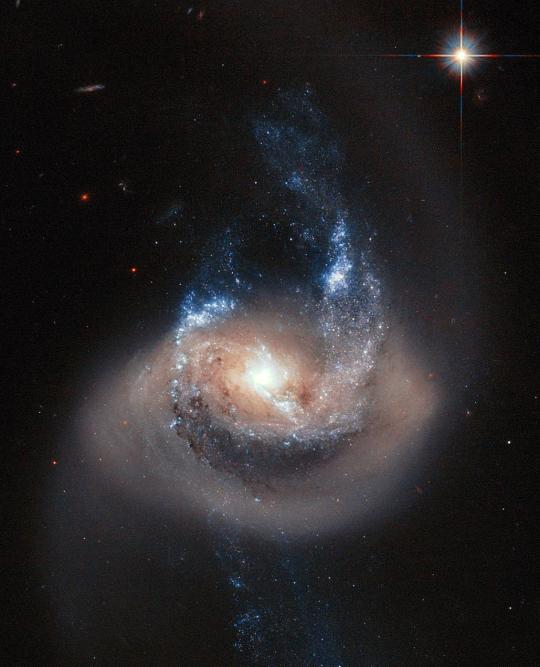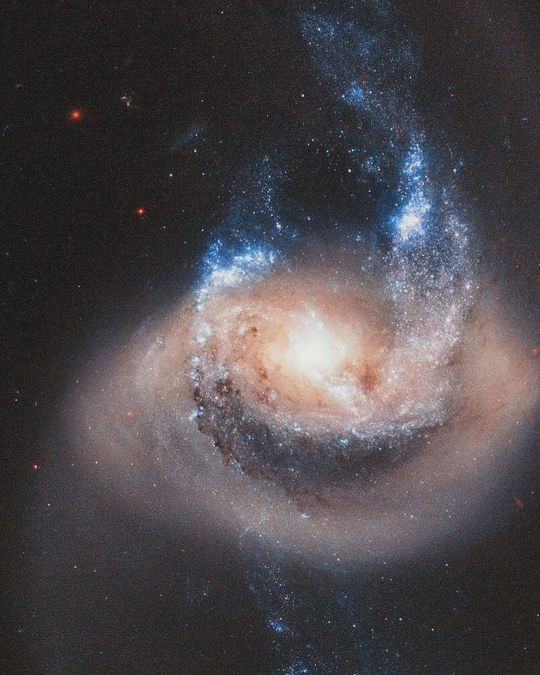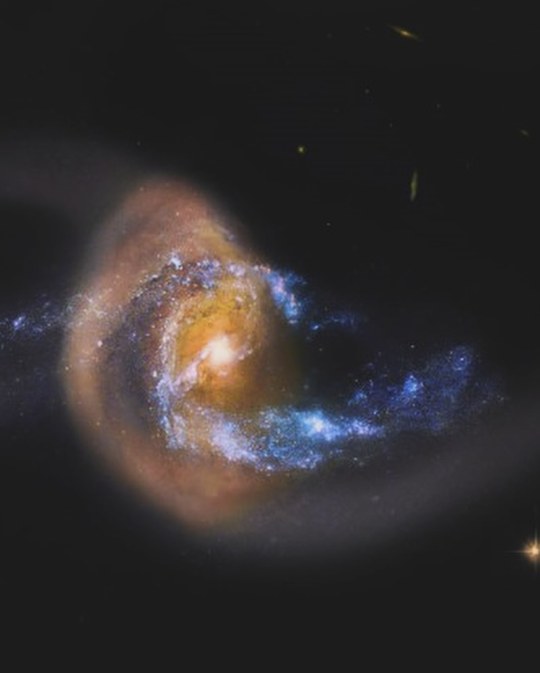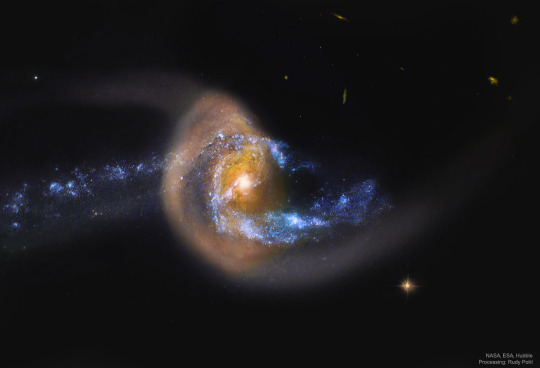#NGC 7715
Text




THE MASTER OF THE UNIVERSE CRUSHES ALL -- WHEN TWO GALAXIES COLLIDE.
PIC(S) INFO: Spotlight on a Hubble image of NGC 7714, a spiral galaxy 100 million light-years from Earth. 🔭+📸: ESA (European Space Agency) & NASA.
MINI-OVERVIEW: "NGC 7714 is a spiral galaxy 100 million light-years from Earth — a relatively close neighbour in cosmic terms.
The galaxy has witnessed some violent and dramatic events in its recent past. Tell-tale signs of this brutality can be seen in NGC 7714's strangely shaped arms, and in the smoky golden haze that stretches out from the galactic centre — caused by an ongoing merger with its smaller galactic companion NGC 7715..."
-- ESA HUBBLE, "Hubble image of NGC 7714," first published in 2015
Acknowledgement: A. Gal-Yam (Weizmann Institute of Science)
Sources: https://esahubble.org/images/heic1503a, Picuki, & X (formerly Twitter).
#NGC 7714#NGC 7715#Galaxies#Spiral Galaxy#Galaxy#Deep Space#Space is Deep#Colliding Galaxies#Galaxy Collision#Hubble Telescope#Outer Space#Hubble Space Telescope#Space Telescope#Astrophotography#Hubble#Cosmic Forces#Astronomy
45 notes
·
View notes
Photo

Arp 284: NGC 7715 (left) and NGC 7714 (right) // Gary Imm
#astronomy#astrophotography#galaxy#spiral galaxy#star-forming galaxy#interacting galaxies#peculiar galaxy#Arp 284#NGC 7715#NGC 7714#pisces
43 notes
·
View notes
Text

This image of NGC 7714, taken by Hubble, shows the effect of an interaction between galaxies. An encounter with NGC 7715, which lies to the left, off frame, started a bout of star formation, seen in the blue arcs around this galaxy’s center: https://bit.ly/4cyLAjj
90 notes
·
View notes
Photo

2024 March 17
NGC 7714: Starburst after Galaxy Collision
Image Credit: NASA, ESA, Hubble Legacy Archive;
Processing & Copyright: Rudy Pohl
Explanation: Is this galaxy jumping through a giant ring of stars? Probably not. Although the precise dynamics behind the featured image is yet unclear, what is clear is that the pictured galaxy, NGC 7714, has been stretched and distorted by a recent collision with a neighboring galaxy. This smaller neighbor, NGC 7715, situated off to the left of the frame, is thought to have charged right through NGC 7714. Observations indicate that the golden ring pictured is composed of millions of older Sun-like stars that are likely co-moving with the interior bluer stars. In contrast, the bright center of NGC 7714 appears to be undergoing a burst of new star formation. The featured image was captured by the Hubble Space Telescope. NGC 7714 is located about 130 million light years away toward the constellation of the Two Fish (Pisces). The interactions between these galaxies likely started about 150 million years ago and should continue for several hundred million years more, after which a single central galaxy may result.
∞ Source: apod.nasa.gov/apod/ap240317.html
89 notes
·
View notes
Text
2024 March 17
A blue spiral galaxy appears to be colliding -- and possibly moving through -- a dusty brown galaxy.

NGC 7714: Starburst after Galaxy Collision
Image Credit: NASA, ESA, Hubble Legacy Archive;
Processing & Copyright: Rudy Pohl
Explanation: Is this galaxy jumping through a giant ring of stars? Probably not. Although the precise dynamics behind the featured image is yet unclear, what is clear is that the pictured galaxy, NGC 7714, has been stretched and distorted by a recent collision with a neighboring galaxy. This smaller neighbor, NGC 7715, situated off to the left of the frame, is thought to have charged right through NGC 7714. Observations indicate that the golden ring pictured is composed of millions of older Sun-like stars that are likely co-moving with the interior bluer stars. In contrast, the bright center of NGC 7714 appears to be undergoing a burst of new star formation. The featured image was captured by the Hubble Space Telescope. NGC 7714 is located about 130 million light years away toward the constellation of the Two Fish (Pisces). The interactions between these galaxies likely started about 150 million years ago and should continue for several hundred million years more, after which a single central galaxy may result.
#astronaut#astronomers#not astrology#star#stars#art#astronomy#outer space#space#artist#galaxy#cosmo#astrophysics#NASA#RING OF STARS#Blue stars#hubble space telescope#hubble telescope#telescopes#130 million years
26 notes
·
View notes
Photo

NGC 7714 Collides With Smaller NGC 7715
#NGC 7714#NGC 7715#nasa#stargazing#astrophoto#astrophotography#galaxy#astronomy#universe#space#nebula#spinningblueball#milky way#milky way galaxy#star
78 notes
·
View notes
Photo

Distant Merger
46 notes
·
View notes
Text

𝑵𝑮𝑪 7714
NGC 7714 is a spiral galaxy 100 million light-years from Earth — a relatively close neighbour in cosmic terms.
The galaxy has witnessed some violent and dramatic events in its recent past. Tell-tale signs of this brutality can be seen in NGC 7714's strangely shaped arms, and in the smoky golden haze that stretches out from the galactic centre — caused by an ongoing merger with its smaller galactic companion NGC 7715, which is out of the frame of this image.
61 notes
·
View notes
Photo

NGC 7714: Starburst after Galaxy Collision : Is this galaxy jumping through a giant ring of stars? Probably not. Although the precise dynamics behind the featured image is yet unclear, what is clear is that the pictured galaxy, NGC 7714, has been stretched and distorted by a recent collision with a neighboring galaxy. This smaller neighbor, NGC 7715, situated off to the left of the featured frame, is thought to have charged right through NGC 7714. Observations indicate that the golden ring pictured is composed of millions of older Sun-like stars that are likely co-moving with the interior bluer stars. In contrast, the bright center of NGC 7714 appears to be undergoing a burst of new star formation. The featured image was captured by the Hubble Space Telescope. NGC 7714 is located about 130 million light years away toward the constellation of the Two Fish (Pisces). The interactions between these galaxies likely started about 150 million years ago and should continue for several hundred million years more, after which a single central galaxy may result. via NASA
635 notes
·
View notes
Photo

NGC 7714: Starburst after Galaxy Collision via NASA https://ift.tt/2LXq8uK
Is this galaxy jumping through a giant ring of stars? Probably not. Although the precise dynamics behind the featured image is yet unclear, what is clear is that the pictured galaxy, NGC 7714, has been stretched and distorted by a recent collision with a neighboring galaxy. This smaller neighbor, NGC 7715, situated off to the left of the featured frame, is thought to have charged right through NGC 7714. Observations indicate that the golden ring pictured is composed of millions of older Sun-like stars that are likely co-moving with the interior bluer stars. In contrast, the bright center of NGC 7714 appears to be undergoing a burst of new star formation. The featured image was captured by the Hubble Space Telescope. NGC 7714 is located about 130 million light years away toward the constellation of the Two Fish (Pisces). The interactions between these galaxies likely started about 150 million years ago and should continue for several hundred million years more, after which a single central galaxy may result.
(Published October 09, 2019)
15 notes
·
View notes
Photo

Is this galaxy jumping through a giant ring of stars? Probably not. Although the precise dynamics behind the featured image is yet unclear, what is clear is that the pictured galaxy, NGC 7714, has been stretched and distorted by a recent collision with a neighboring galaxy. This smaller neighbor, NGC 7715, situated off to the left of the featured frame, is thought to have charged right through NGC 7714. Observations indicate that the golden ring pictured is composed of millions of older Sun-like stars that are likely co-moving with the interior bluer stars. In contrast, the bright center of NGC 7714 appears to be undergoing a burst of new star formation. The featured image was captured by the Hubble Space Telescope. NGC 7714 is located about 130 million light years away toward the constellation of the Two Fish (Pisces). The interactions between these galaxies likely started about 150 million years ago and should continue for several hundred million years more, after which a single central galaxy may result.
NGC 7714: Starburst after Galaxy Collision
Image Credit: NASA, ESA, Hubble Legacy Archive;
Processing & Copyright: Rudy Pohl
https://apod.nasa.gov/apod/ap191009.html?fbclid=IwAR2tZfVhxzZUxNofYXIOzfo1yH1IIsHVz5yf-kGUbq5wq6rxuJ_SfMML7b0
7 notes
·
View notes
Photo

NGC 7714: Starburst after Galaxy Collision via NASA https://ift.tt/2LXq8uK
Is this galaxy jumping through a giant ring of stars? Probably not. Although the precise dynamics behind the featured image is yet unclear, what is clear is that the pictured galaxy, NGC 7714, has been stretched and distorted by a recent collision with a neighboring galaxy. This smaller neighbor, NGC 7715, situated off to the left of the featured frame, is thought to have charged right through NGC 7714. Observations indicate that the golden ring pictured is composed of millions of older Sun-like stars that are likely co-moving with the interior bluer stars. In contrast, the bright center of NGC 7714 appears to be undergoing a burst of new star formation. The featured image was captured by the Hubble Space Telescope. NGC 7714 is located about 130 million light years away toward the constellation of the Two Fish (Pisces). The interactions between these galaxies likely started about 150 million years ago and should continue for several hundred million years more, after which a single central galaxy may result.
2 notes
·
View notes
Text
ARP 284 a Galactic Merger in Pisces
Here is a pair of galaxies from the Arp Atlas of Peculiar Galaxies, this one designated ARP 284 and showing the results of NGC 7714 and NGC 7715 interacting with each other causing a violent and dramatic change in both galaxy shapes. You can see the bridge of stars allowing material to transfer from the smaller galaxy to the larger one. The magnitudes of these galaxies are listed as 13 and 15 in…
View On WordPress
0 notes
Photo

NGC 7714: Galaksi Çarpışması Ardından Yıldız Patlaması
Görsel: NASA, ESA, Hubble Legacy Archive; Görüntü İşleme & Telif: Rudy Pohl
Bu galaksi dev bir yıldız halkasının içinden mi atlıyor? Muhtemelen hayır. Bu görüntünün arkasındaki kesin dinamikler henüz belirsiz olsa da görüntülenen galaksi, NGC 7714, komşu bir galaksiyle yakın zamanda yaşadığı çarpışma tarafından uzatıldığı ve bozulduğu belirli. Daha küçük olan bu komşu, bu karenin sol tarafında bulunan NGC 7715’in, NGC 7714’ün tam içine doğru hücum ettiği düşünülüyor. Gözlemler, görüntüdeki altın halkanın, muhtemelen içerideki daha mavi yıldızlarla birlikte hareket eden, Güneş benzeri milyonlarca yaşlı yıldızdan meydana geldiğini gösteriyor. Bunun aksine NGC 7714’ün parlak merkezi yeni bir yıldız oluşum dalgası yaşıyor gibi görünüyor. Bu görüntü Hubble Uzay Teleskobu tarafından yakalandı. NGC 7714 takımyıldız Balıklar (Pisces) yönünde, yaklaşık 130 milyon ışık yılı mesafede yer alıyor. Bu galaksiler arasındaki etkileşimler muhtemelen 150 milyon yıl önce başladı ve sonuçta tek bir merkezi galaksi ortaya çıkana kadar, birkaç yüz milyon yıl daha devam etmesi gerek.
Görsel: NASA, ESA, Hubble Legacy Archive; Görüntü İşleme & Telif: Rudy Pohl
Günün Astronomi Görseli 9 Ekim 2019 yazısı ilk olarak Uzaydan Haberler sayfasında göründü.
1 note
·
View note
Photo

2019 October 9
NGC 7714: Starburst after Galaxy Collision
Image Credit: NASA, ESA, Hubble Legacy Archive;
Processing & Copyright: Rudy Pohl
Explanation: Is this galaxy jumping through a giant ring of stars? Probably not. Although the precise dynamics behind the featured image is yet unclear, what is clear is that the pictured galaxy, NGC 7714, has been stretched and distorted by a recent collision with a neighboring galaxy. This smaller neighbor, NGC 7715, situated off to the left of the featured frame, is thought to have charged right through NGC 7714. Observations indicate that the golden ring pictured is composed of millions of older Sun-like stars that are likely co-moving with the interior bluer stars. In contrast, the bright center of NGC 7714 appears to be undergoing a burst of new star formation. The featured image was captured by the Hubble Space Telescope. NGC 7714 is located about 130 million light years away toward the constellation of the Two Fish (Pisces). The interactions between these galaxies likely started about 150 million years ago and should continue for several hundred million years more, after which a single central galaxy may result.
∞ Source: apod.nasa.gov/apod/ap191009.html
79 notes
·
View notes
Photo

NGC 7714: Starburst after Galaxy Collision
Is this galaxy jumping through a giant ring of stars? Probably not. Although the precise dynamics behind the featured image is yet unclear, what is clear is that the pictured galaxy, NGC 7714, has been stretched and distorted by a recent collision with a neighboring galaxy. This smaller neighbor, NGC 7715, situated off to the left of the featured frame, is thought to have charged right through NGC 7714. Observations indicate that the golden ring pictured is composed of millions of older Sun-like stars that are likely co-moving with the interior bluer stars. In contrast, the bright center of NGC 7714 appears to be undergoing a burst of new star formation. The featured image was captured by the Hubble Space Telescope. NGC 7714 is located about 130 million light years away toward the constellation of the Two Fish (Pisces). The interactions between these galaxies likely started about 150 million years ago and should continue for several hundred million years more, after which a single central galaxy may result.
October 09, 2019
via Space https://ift.tt/2LXq8uK
1 note
·
View note